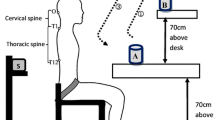Abstract.
The purpose of the current study was twofold: (1) to determine the isometric force and electromyographic (EMG) relationship of the sternocleidomastoid, splenii and trapezii muscles bilaterally in graded and maximal exertions in the sagittal, coronal and oblique planes, and (2) to develop regression equations to predict force based on the EMG scores. A newly designed and validated cervical isometric strength testing device was used to measure the cervical muscle isometric strength and force/EMG relationship in cervical flexion, extension, bilateral lateral flexion, bilateral anterolateral flexion, and bilateral posterolateral extension, all beginning with an upright seated neutral posture. A group of 40 healthy subjects were asked to exert their cervical motions in the directions of interest, while the force output and EMG from the sternocleidomastoids, splenii, and trapezii were sampled bilaterally at 1 kHz. ANOVA, correlation, and regression analyses were carried out. The force and EMG scores were significantly different between the directions of effort (P<0.01). All regressions were significant (P<0.01). All subjects registered the highest forces in pure extension and the lowest in pure flexion, showing a gradual decrease from the posterior to anterior direction. There was a modest correlation between EMG of the investigated muscles and force (r=0.15–0.76, P<0.01). EMG output was, for example, approximately 66% higher in flexion than in extension (while force output was roughly 30% less in flexion than extension) – thus relatively more muscle activity was required in flexion than extension to generate a given force. The intermediate positions (i.e. anterolateral flexion) revealed force/EMG ratio scores that were intermediate in relation to the force/EMG ratios for pure flexion and pure extension. The cervical muscle strength and cervical muscle EMG are therefore dependent on the direction of effort.
Similar content being viewed by others
Author information
Authors and Affiliations
Additional information
Electronic Publication
Rights and permissions
About this article
Cite this article
Kumar, S., Narayan, Y., Amell, T. et al. Electromyography of superficial cervical muscles with exertion in the sagittal, coronal and oblique planes. Eur Spine J 11, 27–37 (2002). https://doi.org/10.1007/s005860100318
Received:
Revised:
Accepted:
Published:
Issue Date:
DOI: https://doi.org/10.1007/s005860100318




